|
|
VECSEL
|
Introduction
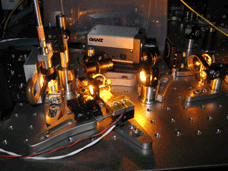
|
|
Frequency-doubled 1178nm-VECSEL.
|
Vertical external cavity surface emitting lasers (VECSEL) can provide
high out put powers with excellent beam quality in a rather simple and robust
device set-up. The intrinsic gain medium, semiconductor quantum wells can
be designed for a wide variety of operating wavelengths that are difficult
to access with other laser concepts. VECSEL have already been successfully
demonstrated for wavelengths between 670nm and 2.4µm and
with output powers from a single chip of over 80W in CW operation
and over 360W in pulsed operation. Thanks to the open cavity concept
intra- (and external) cavity frequency multiplying allows these devices to reach even wavelengths
in the UV. Frequency-selective filters can be inserted
for wavelength tuning and single frequency operation.
ACMS works on extending the wavelength range of VECSEL by
developing solutions for the mid-IR as well as the visible and UV. We also
work on further improving the operating characterstics, pushing for higher output powers
and efficiencies. Simulation software developed at ACMS is made available
commercially through the spin-off company
Nonlinear Control Strategies Inc..
|

|
|
Theory
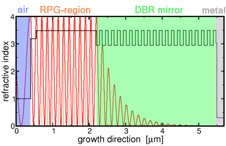
|
|
Index- and mode-profile of a VECSEL.
|
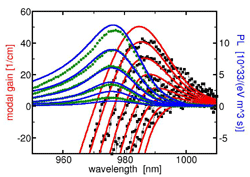
|
|
Edge-PL and gain. Lines: theory. Symbols: Experiment.
|
VECSEL present a stringent challenge and
quality test for theoretical semiconductor models. Here, the lasing wavelength
is determined by the sub-cavity resonance.
The performance depends on the spectral detuning between
this resonance and the gain maximum.
Under typical high-power operation, pump-induced heating
increases the temperature of the active region significantly.
This changes the detuning between cavity resonance and gain
and reduces the gain for a given carrier concentration/pump power.
Thus, in order to predict the performance, the theory
has to be able to reliably compute the absorption/gain for wide parameter
ranges for their
temperature-, density- and spectral dependence. The same is required for non-radiative
carrier losses that are a source for the heating.
|
|
Microscopic Design
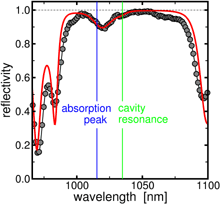
|
|
VECSEL reflectivity. Line: theory. Dots: experiment.
|
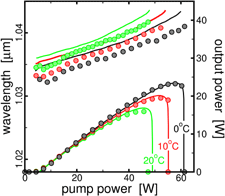
|
|
Calculated (lines) vs. measured (circles) VECSEL operating characteristics.
|
In collaboration with theoreticians at the Philipps University Marburg, Germany,
and others, ACMS has been developing fully microscopic many-body models for the
description of all material characteristics that are at the heart of semiconductor
laser operation, optical gain/absorption, carrier induced refractive index changes,
spontaneous emission (PL) as well as carrier losses due to radiative and Auger losses.
These models distinguish themselves from traditional semi-empirical models
not only through far superior accuracy, but also due to the fact that they
eliminate the dependence on fit-parameters and, thus, pre-existing experimental data.
Their capabilities have been proven in particular through the successful
design and analysis of VECSEL devices. Using these models has allowed to
develop VECSEL in a single design-to-growth iteration. They lead to record performance devices and
vastly improved device analysis.
|
|
Microscopic Device Analysis
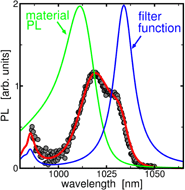
|
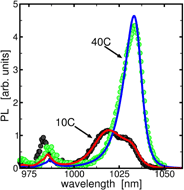
|
|
Microscopically calculated surface PL (red, blue)
versus experiment (circles).
|
Surface photo luminescence
(PL) and reflectivity measurements are ideal for device analysis
since they are non-destructive and can be done at an
early on-wafer stage. In a VECSEL the surface PL is strongly influenced by cavity effects.
It usually does not have its maximum at the same wavelength
as the pure quantum well (material) PL and possibly displays additional peaks.
A correct analysis therefore requires correct material PL lineshapes
as well as a model for the optical mode shapes and the resulting interferences.
Since the surface PL depends crucially on the spectral dependence of the
cavity modifications (represented through the so-called filter function)
as well as the material PL, it represents a very sensitive test for the theory.
Provided the correct material PL, it is also yields crucial information
about the quantum wells as well as the well separation and DBR layers.
|
|
Macroscopic Modeling
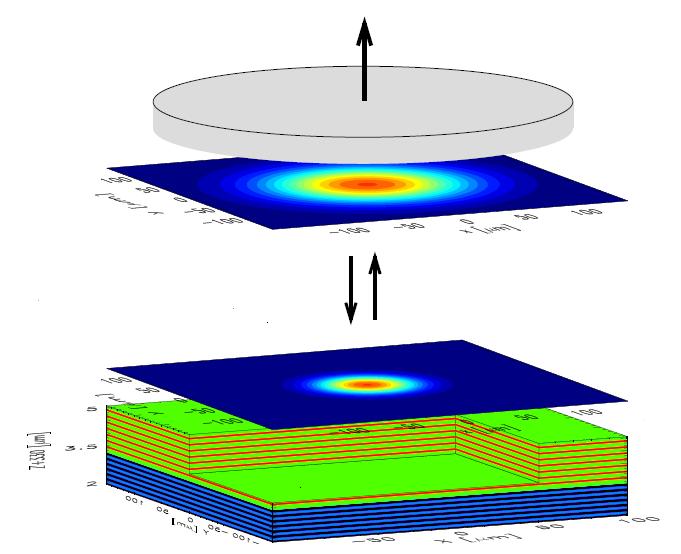 ACMS has developed a simulatior for continuous wave optically pumped VECSEL aimed at modeling output-power limiting
processes in high-power devices. A computational model has been developed for numerical simulation of high-power VECSEL.
The model accurately represents interaction of the optical field with the quantum wells and computes temperature
distribution in the active region. Effects of the gain peak and cavity resonance detuning, diffraction losses and quality
of the thermal management on the maximum output power can be computed.
ACMS has developed a simulatior for continuous wave optically pumped VECSEL aimed at modeling output-power limiting
processes in high-power devices. A computational model has been developed for numerical simulation of high-power VECSEL.
The model accurately represents interaction of the optical field with the quantum wells and computes temperature
distribution in the active region. Effects of the gain peak and cavity resonance detuning, diffraction losses and quality
of the thermal management on the maximum output power can be computed.
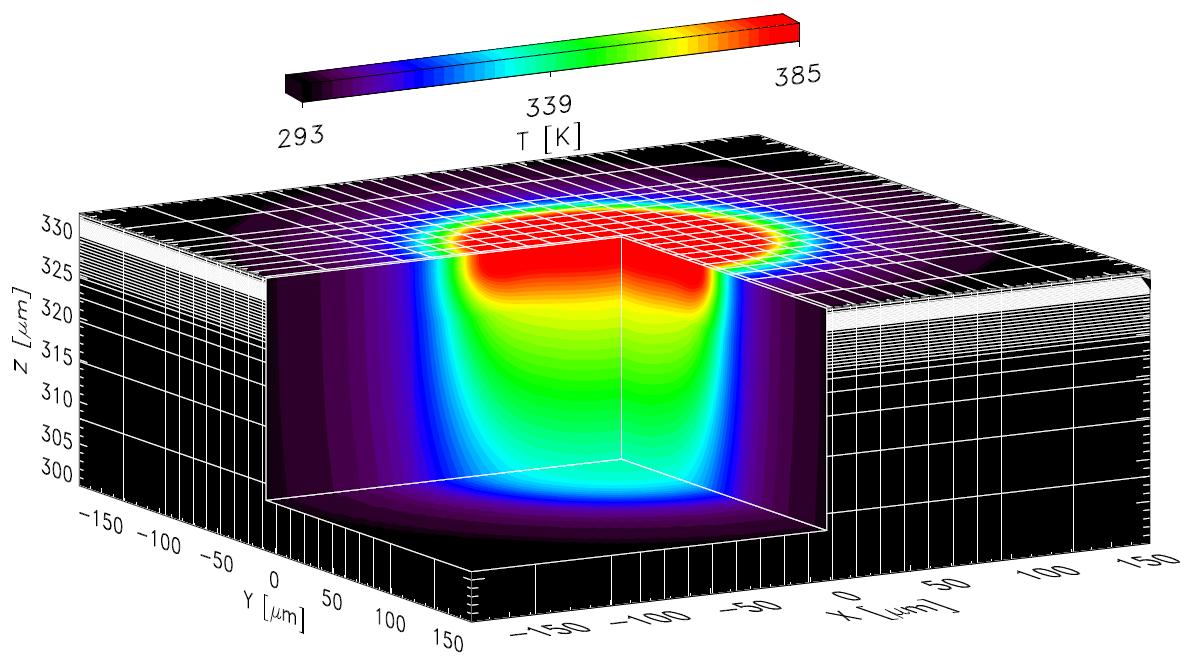 The optical material properties are dependent on temperature, carrier density and wavelength which are pre-computed
using fully microscopic many-body models and serve as input for the active region Bi-directional Beam Propagation Method (Bi-BPM)
Carrier rate equations are applied in the VECSEL semiconductor subcavity to model interaction of the optical
field with the QWs.
The optical material properties are dependent on temperature, carrier density and wavelength which are pre-computed
using fully microscopic many-body models and serve as input for the active region Bi-directional Beam Propagation Method (Bi-BPM)
Carrier rate equations are applied in the VECSEL semiconductor subcavity to model interaction of the optical
field with the QWs.
The temperature distribution in the active region of the device is computed
by solving steady-state thermal transport equation in the semiconductor and submount layers. At high temperatures and
carrier densities, the thermally induced output power roll-over is dependent on the carrier recombination due to
defect-, radiative- and Auger processes. Spectral propagator of the optical field is used to model the external cavity - transverse mode size.
|

|
|
Experiment
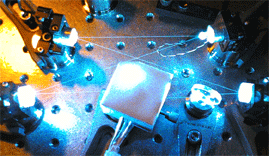
|
|
CW 244nm lasing by 4HG of a 976nm VECSEL.
|
ACMS collaborates with experimentalists at the College of Optical Sciences, University of Arizona,
as well as growers and experimentalists from the Philipps University Marburg, Germany,
the University of New Mexico, the AFRL, Wright Patterson, AFB, Ohio and others on
realizing VECSEL for higher powers, new wavelengths and overall better performance.
In order to achieve better VECSEL performance, improved device processing, bonding- and cooling-concepts
are being developed.
Power scaling is pursued using, e.g., pump-spot size variation and multi-chip operation.
Record powers of over 360W at 2µm and over 200W at 1040nm have been
achieved using pulsed excitation. Using frequency doubling and quadrupling lasing at wavelengths
that are hard to access
with other laser systems, like the sodium-ion line at 589nm or 244nm have been demonstrated.
|
|
High-Power CW VECSEL
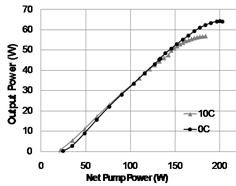
|
|
CW LI-characteristic of a 1040nm VECSEL.
|
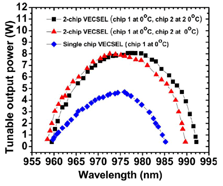
|
|
Tuning range in a one and two-chip VECSEL set-up.
|
VECSEL performance strongly deteriorates with increased heating of the device.
Active and passive cooling through micro-channel coolers or intra-cavity diamond
heat spreaders are important device concepts when attempting maximum output power.
However, these introduce challenges since they require accurate device processing and
challenging mounting processes.
The achievable output power of a VECSEL can also be increased by scaling the pump spot size.
However, at a certain spot size lateral lasing and non-ideal heat dissipation start to diminish
this power scaling. Coherent combination of beams from multiple chips can also be used to scale
the power but introduces challenging device configuration problems.
ACMS has achieved record CW output power of over 60W from a single chip 1040nm VECSEL. We have also
demonstrated power scaling through multi-chip arrangements. The later concept has been shown
to allow for increased wavelength tuning at significant output powers. Work on improved performance
through improved processing, mounting, cooling and pump-spot scaling continues.
|
|
Pulsed Performance
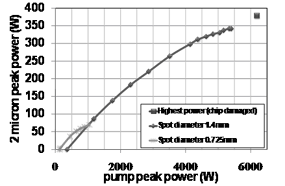
|
|
LI-characteristic for a pulsed-pumped 2µm-VECSEL.
|
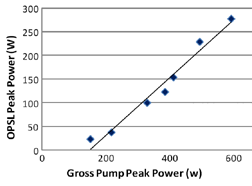
|
|
LI-characteristic for a pulsed-pumped 1040nm-VECSEL.
|
Pulsed excitation with a low duty-cycle and short pulses (nanoseconds to microseconds)
can be used to reduce the heating of VECSEL and, thus, allow for higher peak powers.
ACMS has achieved record peak powers of over 350W from a 2µm-VECSEL. Here,
the achieved output-power was somewhat limited by a rather large excess energy
of the pump-source (1064nm).
Almost 300W peak power has been achieved for a 1040nm-VECSEL. This device
was designed for CW excitation with a rather large detuning between cavity resonance
and quantum well gain in order to account for the anticipated heating and related
spectral shifts. Further improvements are expected using devices with adjusted designs.
|
|
Frequency Multiplying
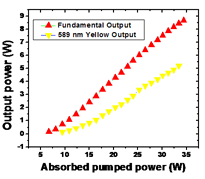
|
|
Fundamental and frequency doubled power of a 1178nm VECSEL.
|
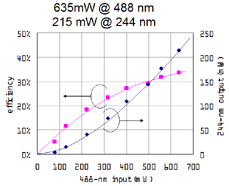
|
|
Power of a 4HG 976nm-VECSEL.
|
The open cavity concept and high powers of VECSEL make them ideal for frequency multiplying.
Etalons for wavelength selection can be inserted into the cavity in order to allow
for wavelength selectivity which is also important for the frquency doubling
to achieve specific wavelengths. Devices
achieving wavelengths in the visual based on these concepts have already reached the commercial stage.
The wide variety of wavelengths that can be achieved with semiconductor quantum wells as active
material and the flexibility of pump-wavelengths allows VECSEL to reach many wavelngths
that are fairly in-accesible to other laser systems. Combined with wavelength
multiplying, ACMS has already demonstrated high power emission at the sodium ion
line, 589nm, using frequency doubling and wavelengths in the deep-UV through
frequency quadrupling.
|

|
|
Recent Publications
Alexandre Laurain, Cody Mart, Joerg Hader, Jerome V. Moloney, Bernadette Kunert and Wolfgang Stolz,
"Optical noise of stabilized high-power single frequency optically pumped semiconductor laser", Optics Letters, 39, 1573 (2014)
J. V. Moloney, I. Kilen, A. Bäumner, M. Scheller and S. W. Koch, "Nonequilibrium and thermal effects in mode-locked VECSELS", Optics Express, 22, 6422 (2014)
Laurain, A., Mart, C., Hader, J., Moloney, J.V., Kunert, B., Stolz, W., "15W Single Frequency Optically Pumped Semiconductor Laser With Sub-MHz Linewidth.," Photonics Technology Letters, IEEE , 26, 131-133 (2014).
Ahirwar, P., Rotter, T., Shima, D., Jahan, N., Clark, S., Addamane, S., Balakrishnan, G., Laurain, A., Hader, J., Lai, Y., Moloney, J., Suemune, I., Bedford, R., "Growth and optimization of 2 µm InGaSb/AlGaSb quantum well based VECSELs on GaAs/AlGaAs DBRs." IEEE Journal of Selected Topics in Quantum Electronics, 19, 1700611, (2013)
Matthias Wichmann, Mohammad Khaled Shakfa, Fan Zhang, Bernd Heinen, Maik Scheller, Arash Rahimi-Iman, Wolfgang Stolz, Jerome V. Moloney, Stephan W. Koch, and Martin Koch "Evolution of multi-mode operation in vertical-external-cavity surface-emitting lasers", Optics Express, 21, 31940 (2013)
J. R. Paul, M. Scheller, A. Laurain, A. Young, S. W. Koch and J. Moloney. "Narrow linewidth single-frequency terahertz source based on difference frequency generation of vertical-external-cavity source-emitting lasers in an external resonance cavity," Opt. Lett., OSA, 38, 3654-3657 (2013)
J. Hader, T.-L. Wang, J. V. Moloney, B. Heinen, M. Koch, S. W. Koch, B. Kunert, and W. Stolz "On the measurement of the thermal impedance in vertical-external-cavity surface-emitting lasers", J. Applied Physics, 113, 153102 (2013)
A. Chernikov, M. Wichmann, M.K. Shafka, M. Scheller, J.V. Moloney, S.W. Koch and M. Koch, "Time-dynamics of the two-color emission from vertical-external-cavity surface-emitting lasers", Appl. Phys. Lett., 100, 041114 (2012)
Alexander Laurain, Tsuei-Lian Wang, Michael J. Yarborough, Jorg Hader, Jerome V. Moloney, Stephan W. Koch, Bernadette Kunert, Wolfgang Stolz, "High Peak Power Operation of a 1 µm GaAs-Based Optically Pumped Semiconductor Laser", IEEE Photonics Technology Letters, 24, 380 (2012).
B. Heinen, T.-L. Wang, M. Sparenberg, A. Weber, B. Kunert, J. Hader, S.W. Koch, J.V. Moloney, M. Koch, and W. Stolz, "106W continuous-wave output power from vertical-external-cavity surface-emitting laser," Electron. Lett. 48, 516 (2012).
T.-L. Wang, B. Heinen, J. Hader, C. Dineen, M. Sparenberg, A. Weber, B. Kunert, S.W. Koch, J. V. Moloney, M. Koch, and W. Stolz, "Quantum design strategy pushes high-power vertical-external-cavity surface-emitting lasers beyond 100W," Laser Photonics Rev., 10, 1002 (2012).
M. Scheller, S. W. Koch, and J. V. Moloney, "Grating-based wavelength control of single- and two-color vertical-external-cavity-surface-emitting lasers," Optics Letters, 37, 25-27 (2012).
M. Scheller, T.-L. Wang, B. Kunert, W. Stolz, S. W. Koch, and J. V. Moloney, "Passively mode-locked VECSEL emitting 682 fs pulses with 5.1 W of average output power," Electronics Letters, 48 (2012).
M. Scheller, A. G. Young, J. M. Yarborough, J. V. Moloney, S. W. Koch, C. Y. Drouet d'Aubigny, and C. K. Walker, "Heterodyne Detection of Intracavity Generated Terahertz Radiation," IEEE Transactions on Terahertz Science and Technology, 2, 271 (2012).
R. Bedford, G. Triplett, D. Tomich, J. Moloney, S. Koch, and J. Hader, "Reduced Auger Recombination in Mid-Infrared Semiconductor Lasers," Journal of Applied Physics, 110, (7), (2011).
J. Hader, J.V. Moloney, and S.W. Koch, "Temperature-dependence of the internal efficiency droop in GaN-based diodes," Appl. Phys. Lett. 99, 181127 (2011).
T. Lermer, A. Gomez-Iglesias, M. Sabathil, J. Müller, S. Lutgen,1 U. Strauss, B. Pasenow, J. Hader, J. V. Moloney, S. W. Koch, W. Scheibenzuber, and U. T. Schwarz, "Gain of blue and cyan InGaN laser diodes", Applied Physics Letters, 98, 021115 (2011).
R. Alexander, Albrecht. Christopher P. Hains, Thomas J. Rotter, Andreas Stintz, Kevin J. Malloy, Ganesh Balakrishnan, Jerome V. Moloney, "High power 1.25 µm InAs quantum dot vertical external-cavity surface-emitting laser," J. Vac. Sci. Technol. B, 29, 03C113 (2011).
S. P. R. Clark, P. Ahirwar, F. T. Jaeckel, C. P. Hains, A. R. Albrecht, T. J. Rotter, L. R. Dawson, G. Balakrishnan, P. E. Hopkins, L. M. Phinney, Hader, and J. V. Moloney, "Growth and thermal conductivity analysis of polycrystalline GaAs on chemical vapor deposition diamond for use in thermal management of high-power semiconductor lasers," J. Vac. Sci. Technol. B, 29, 03C130 (2011).
P. Ahirwar, S. P.R. Clark, V. Patel, T. J. Rotter, C. Hains, A. Albrecht, L. R. Dawson, and G. Balakrishnan, J. , "Perforated (In)GaSb quantum wells on GaSb substrates through the use of As2 based in situ etches," Vac. Sci. Technol. B, 29, 041204 (2011).
Jörg Hader, Tsuei-Lian Wang, J. Michael, Yarborough, Colm A. Dineen, Yushi Kaneda, Jerome V. Moloney, Bernadette Kunert, Wolfgang Stolz, and Stephan W, "VECSEL Optimization Using Microsopic Many-Body Physics," IEEE Journal of Selected Topics in Quantum Electronics, 99, (2011).
A. Chernikov, J. Herrmann, M. Koch, B. Kunert, W. Stolz, S. Chatterjee, S.W. Koch, T.L. Wang, Y. Kaneda, J.M. Yarborough, J. Hader and J.V. Moloney, "Heat management in high-power vertical-external-cavity surface-emitting lasers," IEEE Journal of Selected Topics in Quantum Electronics, 99, (2011)
R. Bedford, G. Triplett, D. Tomich, J. Moloney, S. Koch, and J. Hader, "Reduced Auger Recombination in Mid-Infrared Semiconductor Lasers," Journal of Applied Physics, 110, (7), (2011).
A. Chernikov, J. Herrmann, M. Scheller, M. Koch, B. Kunert, W. Stolz, S. Chatterjee, S. W. Koch, T. L. Wang, Y. Kaneda, J. M. Yarborough, J. Hader, and J. V. Moloney, "Influence of the spatial pump distribution on the performance of high power vertical-external-cavity surface-emitting lasers," Applied Physics Letter, 97, 191110 (2010).
C. Hessenius, N. Terry, M. Fallahi, J. Moloney, and R. Bedford, "Gain coupling of class-A semiconductor lasers," Optics Letters, 35, 3060 (2010).
J. Hader, G. Hardesty, T.-L. Wang, M.J. Yarborough, Y. Kaneda, J.V. Mooney, B. Kunert, W. Stolz, and S.W. Koch,
"Predictive Microscopic Modeling of VECSELs," IEEE J. Quantum Electron. 46, 810 (2010).
Y.-Y. Lai, J.M. Yarborough, Y. Kaneda, J. Hader, J.V. Moloney, T.J. Rotter, G. Balakrishnan, C. Hains, and S.W. Koch,
"340W peak power from a GaSb 2µm Optically Pumped Semiconductor Laser (OPSL) grown mismatched on GaAs,"
IEEE Photon. Technol. Lett., accepted for publication.
C. Buckers, E. Kuhn, C. Schlichenmaier, S. Imhof, A. Thranhardt, J. Hader, J.V. Moloney, O. Rubel, W. Zhang,
T. Ackermann, and S.W. Koch, "Quantum modeling of semiconductor gain materials and vertical-external-cavity
surface-emitting laser systems," Phys. Stat. Sol. B - Basic Sol. Stat. Phys. 247, 789 (2010).
T.-L. Wang, Y. Kaneda, M. Yarborough, J. Hader, J.V. Moloney, A. Chernikov, S. Chatterjee, S.W. Koch, B. Kunert, and
W. Stolz, "High-Power Optically Pumped Semiconductor Laser at 1040nm," IEEE Photon. Technol. Lett. 22, 661 (2010).
A.R. Albrecht, T.J. Rotter, C.P. Hains, A. Stintz, J.V. Moloney, K.J. Malloy and G. Balakrishnan, "Multiwatt 1.25 2µm quantum dot VECSEL," Electronics Letters, 46, 856 (2010); featured as "New high for quantum dot VECSELs" Electronics Letters, 46, 807 (2010).
J. Hader, J.V. Moloney, and S.W. Koch, "Density-activated defect recombination as a possible explanation for the efficiency droop in GaN-based diodes," Applied Physics Letters, 96, 221106 (2010).
E. Kuhn, S.W. Koch, A. Thranhardt, J. Hader, and J.V. Moloney, "Microscopic simulation of nonequilibrium features in
quantum-well pumped semiconductor disk lasers," Appl. Phys. Lett. 96, 051116 (2010).
T.J. Rotter, J. Tatebayashi, P. Senanayake, G. Balkrishnan, M. Rattunde, J. Wagner, J. Hader, J.V. Moloney,
S.W. Koch, L.R. Dawson, and D.L. Huffaker, "Continuous-Wave, Room-Temperature Operation of 2µm Sb-Based
Optically-Pumped Vertical-External-Cavity Surface-Emitting Laser Monolithically Grown on GaAs Substrates,"
Appl. Phys. Exp. 2, 112102 (2009).
Y. Kaneda, M. Fallahi, J. Hader, J.V. Moloney, S.W. Koch, B. Kunert, and W. Stoltz, "Continuous-wave single-frequency
259nm laser source by a frequency-quadrupled optically pumped semiconductor laser," Optics Lett. 34, 3511 (2009).
J. Hader, J.V. Moloney, and S.W. Koch, "Microscopic analysis of mid-infrared type-II "W" diode lasers", Applied Physics Letters, 94, 061106 (2009).
Shuqi Chen, Weiping Zang, Axel Schülzgen, Xin Liu, Jianguo Tian, Jerome V. Moloney, and Nasser Peyghambarian, "Modeling of Z-scan characteristics for one-dimensional nonlinear photonic bandgap materials", Optics Letter, 34, 3665 (2009)
E. Kuhn, A. Thranhardt, C. Buckers, S.W. Koch, J. Hader, and J.V. Moloney, "Numerical study of the influence on an
antireflection coating on the operating properties of vertical-external-cavity surface-emitting lasers,"
J. Appl. Phys. 106, 063105 (2009).
M. Walton, N. Terry, J. Hader, J. Moloney, and R. Bedford, "Extraction of semiconductor microchip differential gain
by use of optically pumped semiconductor laser," Appl. Phys. Lett. 95, 111101 (2009).
J.M. Yarborough, Y.-Y. Lai, Y. Kaneda, J. Hader, J.V. Moloney, T.J. Rotter, G. Balakrishnan, C. Hains, D. Huffaker,
S.W. Koch, and R. Bedford, "Record pulsed power demonstration of a 2µm GaSb-based optically pumped semiconductor
laser grown lattice-mismatched on an AlAs/GaAs Bragg mirror and substrate," Appl. Phys. Lett. 95, 081112 (2009).
David Love, Miroslav Kolesik, and Jerome V. Moloney, "Optimization of Ultrashort Pulse Generation in Passively Mode-Locked Vertical External-Cavity Semiconductor Lasers", IEEE Journal of Quantum Electronics, 45, 439 (2009).
C. Buckers, S. Imhof, A. Thranhardt, J. Hader, J.V. Moloney, and S.W. Koch, "Microscopic Modeling of Quantum Well Gain
Media for VECSEL Applications," IEEE J. Sel. Topics Quantum Electron. 15, 984 (2009).
M. Fallahi, L. Fan, Y. Kaneda, C. Hessenius, J. Hader, H. Li, J.V. Moloney, B. Kunert, W. Stolz, S.W. Koch, J. Murray,
and R. Bedford, "5-W Yellow Laser by Intracavity Frequency Doubling of High-Power Vertical-External-Cavity Surface-Emitting
Laser," IEEE Photon. Technol. Lett. 20, 1700 (2008).
Y. Kaneda, J.M. Yarborough, L. Li, N. Peyghambarian, L. Fan, C. Hessenius, M. Fallahi, J. Hader, J.V. Moloney, Y. Honda,
M. Nishioka, Y. Shimizu, K. Miyazono, H. Shimatani, M. Yoshimura, Y. Mori, Y. Kitaoka, and T. Sasaki, "Countinuous-wave
all solid-state 244nm deep-ultraviolet laser source by fourth-harmonic generation of an optically pumped semiconductor
laser using CsLiB6O10 in an external resonator," Optics Lett. 33, 1705 (2008).
M. Schafer, W. Hoyer, M. Kira, S.W. Koch, and J.V. Moloney, "Influence of dielectric environment on quantum-well luminescence spectra", J. Opt. Soc. Am. B, 25, 187 (2008).
C. Buckers, A. Thranhardt, S.W. Koch, M. Rattunde, N. Schulz, J. Wagner, J. Hader, J.V. Moloney, "Microscopic calculation and measurement of the laser gain in a (GaIn)Sb quantum well structure", Applied Physics Letter, 92, 0171107 (2008).
S. Imhof, C. Buckers, A. Thranhardt, J. Hader, J.V. Moloney, and S.W. Koch, "Microscopic theory of the optical properties of Ga(AsBi)/GaAs quantum wells", Semiconductor Science Technology, 23, 1 (2008).
|
|
















